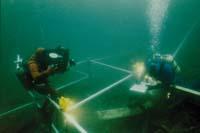Sunken ships: underwater memory
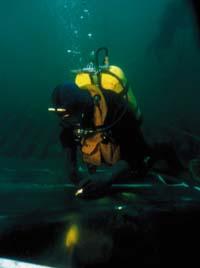
Concha Bay
An important station of the route of the sunken ships is the bay of the Concha. Thousands of people travel every year, during the summer, in the Concha de San Sebastián, splash of plistis... but surely few will know that in those waters, a few meters below, there are remains of several ancient ships. According to data from the Underwater Research Society INSUB of San Sebastian, the seabed of La Concha houses remains of ten ships. Among them are the “watch boat” and the “charter boat”.
The 'Boat of the watches' is located nine meters deep, at the height of the clocks of the Concha... hence its name. In 1999 an exhaustive study of the container was carried out and it was verified that only a fifth of the total structure is preserved, missing bow and pop, leaving only some pieces of wood from the hull. However, they have studied how these pieces are assembled from each other in the XVI. and XVII. that is between centuries. However, the archaeological context is not only formed by the pieces of wood of the ship... this context is also part of the peak of songs that covers the entire ship. Research has found that all of these reefs were the ballast of the ship. The aim of this ballast was to prevent ships from floating too much in the water when they were circulating with little load. As for the load carrying the container, they have found nothing.

The other is 'the ship of the strapping'. The INSUB association has known this ship since the early 1970s. It is sunk in the entrance bar to the bay, approximately at the height of the Aquarium. It is located fourteen meters deep, and when they discovered it was named for sharpened stones and wrought iron strapping, because it was only burdened.
The archeological technicians consider that this charge was of nearby ironworks. In fact, the most marketed iron in the 18th century was the strap. In the 20th century. Subsequently, this iron was used in the forging workshops associated with the shipyards. Nothing remains of the structure of the container… there is no trace of pieces of wood. It has been dissolved by the force of the sea, but also by the worm Teredo navalis... this worm eats all the wood that is not under the sand.
But why did the two ships sink? In the case of the “freight ship” the hypothesis of the catastrophe or the overturn of the ship is discarded. The fact that the bundles and the wheels are consecutive and contiguous suggests that the boat sank on its own due to a bad maneuver. In the case of the “watch boat” it is more difficult to say. Ashes have been found on the seabed, so it may have been sunk by a fire or a storm.
If someone thought of the curiosity of going to see the remains of two ships, he would not find anything, since a few years ago they decided to cover themselves with gravel to protect the archaeological group that form the waste.
Five boats in the estuary of Orio
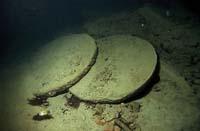
If we head east of the coast of San Sebastian, Orio is the next stop on the route of the sunken ships from the coast of San Sebastian to the east.
Historically, the estuary of Orio has been an important road for commercial navigation and, therefore, witness of numerous sinking. Frequent dredging of the bottom of the estuary for cleaning has resulted in the appearance of the first boat in 1992.
When the INSUB received the discovery notice, they quickly sank to investigate. Five hundred hours of immersion were made and 800 photographs were taken, which were only the beginning. Until 2003, remains and loads of four other boats appeared, all of them XVI. and XVIII. until centuries. The cargo was composed of iron ingots and iron ore, while the remains of the boats constituted about two hundred pieces of wood. All boats were named Orio: Orio I, Orio II, Orio III, Orio IV and Orio V .
Immersed in water, INSUB technicians spent many hours researching the structure of each container, drawing the original layout of each piece and labeling all the pieces. On the other hand, using GPS, the exact location of each of the boats was recorded.
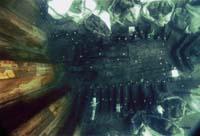
In 2003 archaeologists received a sad surprise: On the left bank of the Oria River a new platform was being built, very close to the old boat of Orio IV. Faced with the danger, those responsible for the works were warned by INSUB, but it was a disaster… the new platform hit the boat. A third of her remained under the platform forever. Archaeologists caught fire. Dressed in neoprene, they took the water chamber and then photographed Orio IV, trapped under the platform. The photo was sent to UNESCO and its president, seeing it, decided to denounce it in a special publication of the institution, on back cover.
The INSUB decided to put aside the anger and continue the work undertaken. The next step was to remove from the waters the pieces of five boats and the cargo dispersed on the seabed. During this work they encountered several objects. Next to the boat Orio II was found a tin jar, probably to keep the wine. After research, they conclude that the jug dates back to 1510.
In Orio IV, remains of a shoe were found among the woods. The shoe was sent to Canada for study and as a wine pitcher, the XVI. They say it is century. Now this shoe is being restored. Once the 200 pieces of Txalupe were extracted from the seabed, they were all transferred to the Agorregi Ferreria in Aia. Today they are kept submerged in the pools of the area. They have to be so that they can be preserved, because after so long the water has become the natural environment of these pieces. If they were left out of the water they would contract.
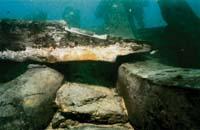
After analyzing the type of boats it has been concluded that all are patachas. This type of boat was used to transport ore along the coast, but it also reached the ferries, since they were small zinc boats, they could circulate through the rivers. In the meadows the ox carts waited for them to collect the iron ore and take them to the ironworks.
The treasure of Urbieta
Without leaving the Cantabrian coast, the Gernika estuary is the location of another "treasure".
The Gernika estuary has been throughout history one of the most important and ancient paths of river navigation in the Basque Country. Thanks to the great depth of the estuary, the boats have been able to easily access from the sea to Gernika, exceeding the 6 kilometers that separate the coast from the land of the interior.
In July 1998, during the Gernika Estuary, an excavator found several pieces of wood under a four-metre layer of mud in an area called Urbieta. They were remains of a container. Gernika Town Hall ordered the halting of the works and the realization of an archaeological study. Scientists began to work and radiocarbon analyses gave a shocking result: the packaging was 1450, before the discovery of America. Thus they discovered, by chance, the oldest ship in Euskal Herria.
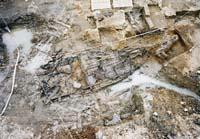
Because of their importance they decided to remove the container from the sticks to recover it. He spent three years in a pile, a mixture of demineralized water and liquid waxes. The aim was to progressively replace the water absorbed by the wood with liquid wax. Thus, the pieces would retain the original volume and shape once dried.
Once the ship's architecture was analyzed, archaeologists saw that it was built with a superimposed system. This system has its origin in Scandinavia, from where it spread to other Atlantic countries during the Middle Ages. They believe he arrived on the Basque coast from Aquitaine. The boat, originally, was 12 meters long and 4 meters long, and to travel the coast and the rivers used candles and oars.
The oldest ship in the Basque Country was exhibited to the public for the first time a year ago and is currently on display at the Maritime Museum of Bilbao.
